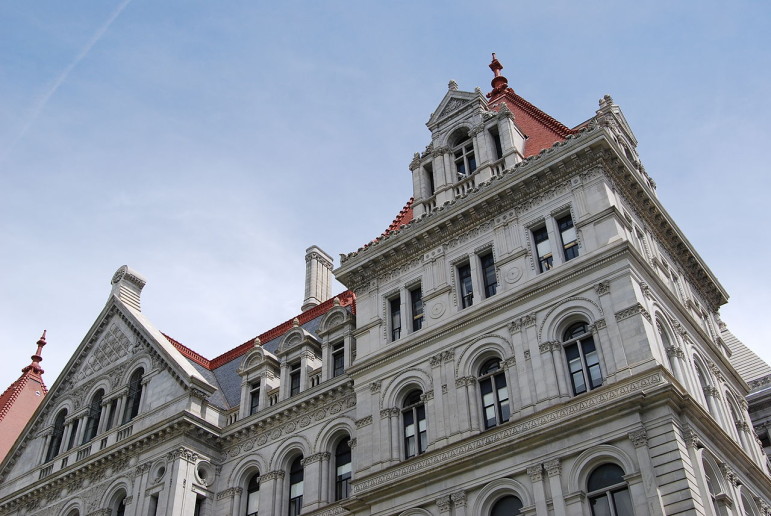
Matt Wade photography
Back in September, when City Limits started covering the rent-regulations saga that ended this week in the state capitol, there was a strong sense of urgency among advocates about how desperately real rent reform was needed. And there was optimism that they’d get it.
Over the past nine months, the optimism waxed and waned—dimmed by election results, raised by changes in Albany leadership, confused by the shifting stance of the governor. The urgency, on the other hand, never abated.
The deal that emerged this week did not leave rent regulations intact. It raised modestly the threshold for taking apartments out of the rent-stabilization system, changed the way landlords could calculate rent bumps when an apartment is vacated and moved to lessen the impact of major capital improvements.
Crucially, however, it left the vacancy decontrol mechanism in place, making it a piece of legislation that the Association for Neighborhood Housing Development says “will hurt New York City tenants and further erode affordable housing throughout the city.” Meanwhile, the bid to meaningfully reform the 421-a tax exemption, while not striking our entirely, fell far short of hopes.
Those defeats are part of a larger failure by progressives to achieve major objectives this year. The minimum wage was not boosted. The age of criminal responsibility was not raised, although Gov. Cuomo will through executive order take some steps toward that goal. A bid to give New York City’s progressive mayor control of the school system through his tenure (and beyond) collapsed. No one seemed to even talk about the DREAM Act.
As the legislative season was playing out, a book by Julian Zelizer called “The Fierce Urgency of Now: Lyndon Johnson, Congress and the Battle for the Great Society,” was getting a lot of play. It’s an excellent book because it picks apart a prevailing myth of popular history—namely that the 1960s were a decade of irresistible liberal dominance personified by a president who happened to be a brilliant legislative strategist. That combination gave us civil rights and the Great Society. Or so it is told.
What Zelizer demonstrates very convincingly is that, as was the case for Franklin Roosevelt during the New Deal and for Barack Obama after his first election, Johnson enjoyed a very short period during which deeply progressive policies were possible. Even then, none of the victories were cakewalks—they required tough negotiation and painful compromises.
When Bill de Blasio was elected, it seemed that another real, progressive moment had arrived. The first-year victories on pre-K, sick leave and municipal ID suggested a new era had indeed begun, even if the mayor lost a battle here and there. Cuomo’s populist state-of-the-state speech this year hinted that perhaps the window was still open. The results of the legislative session indicate that it’s now slammed shut.
Some lay blame for the progressive defeats of 2015 at de Blasio’s doorstep. They fault him because he annoyed GOP leaders by campaigning last year for Democrats to take over the Senate, or sent up his proposal for rent-regulation reform too late or spent to much time working outside the state toward a national progressive agenda.
But de Blasio’s role might have been less important to the outcome than the simple math in Albany. Fact is, progressives faced even longer odds in the capitol in 2015 than they did a year earlier when GOP control depended on the breakaway, centrist Independent Democratic Conference.
Zelizer’s book offers an instructive parallel. Back in 1963-1966, the period when the most significant Great Society and civil rights bills passed, Johnson’s legislative instincts and personal effort were handy. But his legislative success largely reflected the makeup of Congress. LBJ’s famous “treatment” couldn’t convince racist southerners to accede to the end of legalized segregation, but he could help orchestrate a dignified surrender when the segregationists saw overwhelming numbers on the other side. When midterm elections moved the numbers back in conservatives’ favor, the frenzied pace of progressive lawmaking slowed to a crawl, despite LBJ’s considerable charm.
Rent regulations will next sunset in June of 2019. The state’s political makeup might change significantly before then. The 2016 presidential race could engage new voters, and state legislative races that year have the potential to alter the landscape. City elections in 2017 will decide if de Blasio gets a second term and, if so, what kind of mandate he has. Another round of legislative elections and, more importantly, a race for governor could truly reshape state politics in 2018.
If, somewhere in that timeline, another progressive moment presents itself, it will probably be just as short as the most recent one, requiring the left to rush its priorities through before the tide turns again.
If that seems like a depressing diagnosis—and, yeah, it is—there is something of a silver lining. At the very least, it means that the “great man” version of civics isn’t what counts. Bottom-up organizing, starting at the ballot box, is really as important as we’ve all always said it is. As Zelizer writes:
” … we must understand that the Great Society wasn’t all about one man’s political talents or gifts or magic. Nor was it the result of a Congress that naturally worked, where members got along and naturally knew how to legislate. The political acumen Johnson and his colleagues on Capitol Hill possessed was essential, but what made the difference was the forces that temporarily reshaped Congress and broke the hold of conservatives on that notoriously inertial institution. A grassroots movement and a sea change election were critical to the liberal ascendancy that overwhelmed, if briefly, the forces of conservatism that had been and are today, so strong.”
City Limits coverage of public housing and New York’s rental affordability crisis is supported by the Charles H. Revson Foundation.








